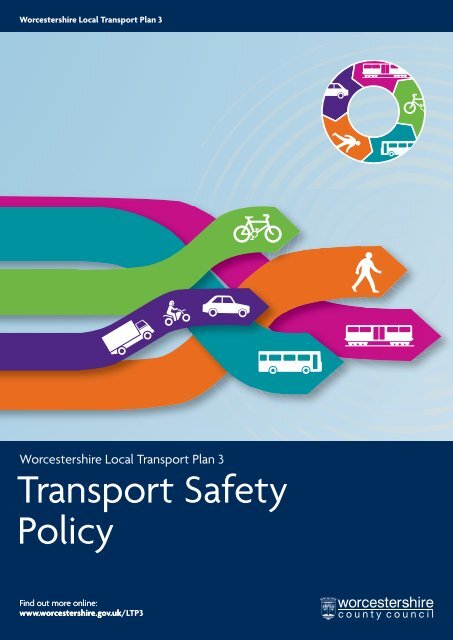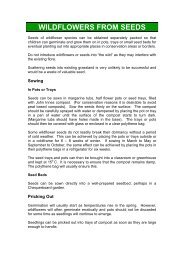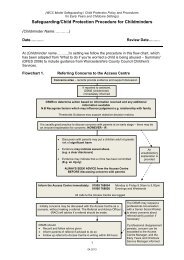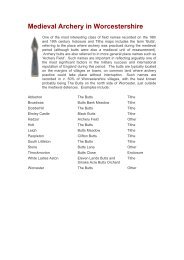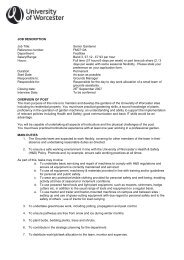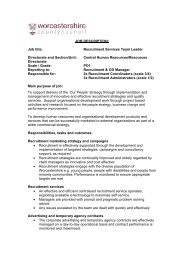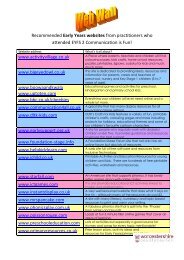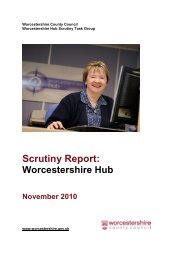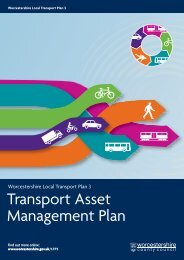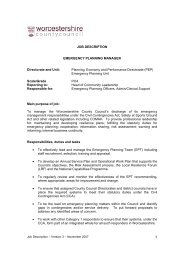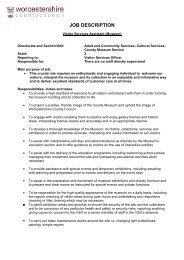Transport Safety Policy - Worcestershire County Council
Transport Safety Policy - Worcestershire County Council
Transport Safety Policy - Worcestershire County Council
You also want an ePaper? Increase the reach of your titles
YUMPU automatically turns print PDFs into web optimized ePapers that Google loves.
<strong>Worcestershire</strong> Local <strong>Transport</strong> Plan 3<strong>Worcestershire</strong> Local <strong>Transport</strong> Plan 3<strong>Transport</strong> <strong>Safety</strong><strong>Policy</strong>Find out more online:www.worcestershire.gov.uk/LTP3
1.1.1 <strong>Worcestershire</strong>’s <strong>Transport</strong> <strong>Safety</strong> <strong>Policy</strong> provides the strategic framework for the developmentof measures which will help to improve the safety of the existing transport network and toencourage use of sustainable transport modes (walk, cycle and passenger transport) where thesecan offer a viable alternative to the car. This policy document sets out the <strong>Worcestershire</strong> <strong>County</strong><strong>Council</strong> <strong>Transport</strong> <strong>Safety</strong> policy and the delivery of road safety schemes. The document sets outthe technical processes underpinning the delivery of road safety measures.1.1.2 A safe transport network is essential in order to give people, in both the urban and rural areas of<strong>Worcestershire</strong>, access to the opportunities and benefits that contribute to the enjoyment of abetter quality of life. <strong>Transport</strong> user needs (including freight) will continue to be met by acombination of road, rail, bus, community transport and taxi services (or similar initiatives) or anyappropriate combination of these modes. Each of these activities and modes has interlinkedstrategies and common aims. Their provision will be integrated to provide the most effectivetransport system that will deliver against identified socio-economic objectives. The<strong>Worcestershire</strong> <strong>Transport</strong> <strong>Safety</strong> <strong>Policy</strong> has been developed to support the delivery of anefficient multi-modal transport network where modal choice is maximised.1.1.3 The purpose of the <strong>Worcestershire</strong> <strong>Transport</strong> <strong>Safety</strong> <strong>Policy</strong> is to set out the processes andapproach required to establish the safest transport network and facilities which will address theneeds of both current and potential future users in <strong>Worcestershire</strong> and deliver the transportobjectives of the Government and <strong>Worcestershire</strong> <strong>County</strong> <strong>Council</strong>.1.1.4 The starting point for this <strong>Worcestershire</strong> <strong>Transport</strong> <strong>Safety</strong> <strong>Policy</strong> is the overall socio-economicobjectives of LTP3, which have been developed to reflect national, regional and local policy whichare outlined in Table 1.1.1.1.5 The <strong>Worcestershire</strong> <strong>Transport</strong> <strong>Safety</strong> <strong>Policy</strong> must also support the <strong>Worcestershire</strong> SustainableCommunity Strategy (WSCS) which includes the following six themes, all of which are influencedby the performance and availability of transport infrastructure and services:Communities that are safe and feel safe;A better environment for today and tomorrow;Economic success that is shared by all;Improving health and well being;Meeting the needs of children and young people; andStronger Communities (including housing, culture, poverty and volunteering).1.1.6 Table 1.1 identifies how the <strong>Worcestershire</strong> <strong>Transport</strong> <strong>Safety</strong> <strong>Policy</strong> will contribute towardsachieving the wider socio-economic objectives of the LTP3 and <strong>Worcestershire</strong> SustainableCommunity Strategy.
Table 1.1 – The <strong>Transport</strong> <strong>Safety</strong> <strong>Policy</strong> and How It Will Deliver Against <strong>Worcestershire</strong> Local<strong>Transport</strong> Plan 3 and Sustainable Community Strategy ObjectivesTosupport<strong>Worcestershire</strong>'seconomiccompetitiveness andgrowth throughdelivering a reliableand efficient transportnetworkTo reduce the impactsof transport in<strong>Worcestershire</strong> on thelocal environment, byreducing noise andtransport-relatedemissions of carbondioxide and othergreenhouse gases, withthe desired outcomesof tackling climatechange and reducingthe impacts oftransport on publichealthEconomicsuccess that isshared by allStrongerCommunitiesA betterenvironment fortoday andtomorrowEach road traffic collision generates costs in termsof resources, lost production, health-care and socialbenefits. It is nationally recognised that suchcollisions can be estimated to cost the country1almost £18 billion per year. The value for<strong>Worcestershire</strong> can be calculated as almost £1.4million. Thus <strong>Worcestershire</strong>'s economy will benefitas a direct result of a reduction in road casualties.Road traffic accidents are often the cause of majorcongestion incidents and even damage onlyaccidents can cause significant disruptionparticularly if they occur on busy roads and at peaktimes.Major congestion incidents can be caused by roadaccidents, even if damage only. The congestioncan then create temporary localised air qualityproblems. Both actual and perceived trafficdangers can be a significant deterrent to walkingand cycling resulting in greater car usage for tripsthat could have otherwise be made by sustainablemodes. This increase in unnecessary car tripsincreases the transport carbon footprint and addsto local air quality problems.To contribute towardsbetter safety, security,health and longer lifeexpectancyin<strong>Worcestershire</strong>, byreducing the risk ofdeath, injury or illnessarising from transportand promoting healthymodes of travelCommunitiesthat are safe andfeel safeClearly there is a direct link between improved roadsafety and public health in terms of reduced roadcasualties. In addition improvements in road safetyfor walking and cycling encourages greater activityand contributes to the corresponding healthbenefits.
To optimise equality ofopportunity for all of<strong>Worcestershire</strong>'scitizens with thedesired outcome ofcreating a fairersociety.StrongerCommunitiesMeeting theneeds ofchildren andyoung peopleWhen people feel that the road network is unsafeto walk or cycle a particular route, their journeychoices become limited. For those without accessto a car and where public transport is not a viableoption this leads to reduced opportunity foremployment, health care, education, shopping andrecreation and contributing to social exclusion.To enhance the qualityof life for<strong>Worcestershire</strong>'sresidents by promotinga healthy, naturalenvironment,conserving our historicbuilt environment andpreserving our heritageassetsImprovinghealth and wellbeing;Any prevalent or even perceived hazardsthroughout an area reduces the ability for the publicto be able to enjoy the area to it's full potential.Residential, shopping and recreation areas can beadversely affected by traffic dangers and have amajor detrimental impact on the vitality of the area,hindering people's enjoyment of the space andability to make good use of facilities.To enhance the qualityof <strong>Worcestershire</strong>'s<strong>Transport</strong> Asset,through sensitive andappropriate designwith the desiredoutcome of reducingthe costs andinconvenience ofmaintenance worksStrongerCommunitiesRoad traffic accidents often result in damage tohighway assets. Improved highway design for thereduction of traffic accidents will lead to reducedcosts of accident damage to highway assets.
1.1.7 The target audience for this strategy includes a wide range of stakeholders comprising therepresentatives of the residents of <strong>Worcestershire</strong>, highway network users (across all modes oftransport), voluntary groups, the Department for <strong>Transport</strong>, the <strong>Council</strong>’s local authority andregional partners, rail and bus users and operators, Network Rail, taxi and private hire users andoperators, the Highways Agency and regulatory bodies. To be thorough and robust, this policydocument by necessity covers a wide range of, often technical, issues. The level of technicaldetail is necessary to ensure the document is precise and unambiguous.1.2.1 A Safer Way: Consultation on Making Britain's Roads the Safest in the World (April 2009) set outthe Government’s proposed vision, targets and measures for improving road safety in GreatBritain beyond 2010 and sought feedback on them. On 29 March 2010 DfT advised that 'A SaferWay' should be taken as the best indication available of the developing national vision, targets andmeasures’.1.2.2 'A Safer Way' carries out a thorough review of the evidence and identifies a series of keychallenges nationally. To achieve the vision set out in 'A Safer Way' the Government has proposedthe following national targets for achievement by 2020 compared to a baseline of the 2004-08average:To reduce the number of people killed in road collisions by at least 33%. (The Governmentbelieves that this target is not readily replicable below national level so proposes acombined target for killed or seriously injured at local level).To reduce the number of people seriously injured in road collisions by at least 33%.To reduce the number of children and young people (
1.3.1 <strong>Worcestershire</strong> <strong>County</strong> <strong>Council</strong> analyses reports on all the road traffic injury collisions that arereceived from the West Mercia Police to identify problem sites, routes and areas that may meritfurther investigation for remedial measures.1.3.2 <strong>Worcestershire</strong> <strong>County</strong> <strong>Council</strong> works in partnership with a number of external agencies includingWest Mercia Police Authority and Hereford and Worcester Fire and Rescue Service as the Road<strong>Safety</strong> Partnership in West Mercia to reduce road casualties across <strong>Worcestershire</strong>. The <strong>Transport</strong><strong>Safety</strong> <strong>Policy</strong> will reduce road casualties by combining the three E's:– improvements to the highway infrastructure for accident prevention– introduction of new speed limits and speed and hazard warning signstogether with proven measures to encourage drivers to adhere to them.– training programmes encouraging safer use of the road network that aretailored to meet specific road user groups1.4.1 Each year around 30 people are killed as a result of a road traffic collision on <strong>Worcestershire</strong>s'roads. All road traffic collisions have subsequent human and financial costs placed on individuals,their families and the wider community. Additionally road traffic accidents place a burden on theNational Health Service and Emergency services and other public bodies and create significantcongestion problems. For <strong>Worcestershire</strong>, the cost placed on the collisions that occur on ourroads every year is estimated to be approaching £1.4 million1. Furthermore, road safety concernsare a key deterrent to walking and cycling particularly for children and the mobility impaired.1.5.1 This <strong>Worcestershire</strong> LTP3 <strong>Transport</strong> <strong>Safety</strong> <strong>Policy</strong> has been developed to be fully compliant withall current and relevant National, Regional and Local policy. A summary of these policies isprovided in the LTP3 Essential References Document. In particular, this document is aligned withthe emerging Core Strategies which have been developed by the <strong>Worcestershire</strong> Borough, Cityand District <strong>Council</strong>s.
2.1.1 The <strong>Worcestershire</strong> <strong>Transport</strong> <strong>Safety</strong> <strong>Policy</strong> has a central role to play in the delivery of the LTP3objectives as identified in Table 1.1. This policy considers the strategic application of road safetymeasures in <strong>Worcestershire</strong> and is structured as follows:Understanding and Measuring the ProblemSpeed Limit StrategySpecific road user groups, locations and road typeso Areas of Disadvantageo Childreno Urbano Ruralo Motorcyclistso Route AnalysisEngineeringo Casualty Reductiono Designing Roads for Lower Speedso Signageo Highway <strong>Safety</strong> AuditsEnforcementEducation2.2.1 <strong>Worcestershire</strong> <strong>County</strong> <strong>Council</strong> receives police reports on all road traffic injury collisions thatoccur within the <strong>County</strong> generally this constitutes around 1,500 collisions with 2,000 resultingcasualties per annum. Road casualties are categorised by severity as:Killed or Seriously Injured (KSI)Slight Injury2.2.2 Road traffic injury reports contain details of casualty's age, mode of travel, road and weatherconditions and location and it is <strong>Worcestershire</strong> <strong>County</strong> <strong>Council</strong>'s role to analyse these details toidentify problem sites, routes, areas and road user groups in order to determine appropriateremedial measures.2.2.3 The numbers of KSI casualties across <strong>Worcestershire</strong> has shown improvement over the years overand above the national targets for 2010 as compared with 1998 figures:40% reduction in number of people KSI in road accidents50% reduction in number of children KSI10% reduction in the slight casualty rate expressed as the number of people slightly injuredper 100 million vehicle kilometres
2.2.4 Figures 2.1 and 2.2 show <strong>Worcestershire</strong> data for Killed and Seriously Injured Casualties from 1994to 2009. <strong>Worcestershire</strong>'s road casualty statistics for 2009 compared with 1994 -1998 averagefigures show:65.25 % reduction in all KSIs79.80% reduction in Children KSIs14.39% reduction in Slight InjuriesFigure 2.1 – All Killed or Seriously Injured Casualties in <strong>Worcestershire</strong> from 1994 to 200970060050040030020010001994 1995 1996 1997 1998 1999 2000 2001 2002 2003 2004 2005 2006 2007 2008 2009 2010Actual KSI Casualties 94/98 average TargetFigure 2.2 – Children Killed or Seriously Injured Casualties in <strong>Worcestershire</strong> 1994 - 200990807060504030201001994 1995 1996 1997 1998 1999 2000 2001 2002 2003 2004 2005 2006 2007 2008 2009 2010Actual KSI Casualties 94/98 average Target
2.3.1 The Speed Management Strategy for <strong>Worcestershire</strong> aims to balance the needs of traffic flowwith the safety of all road users by applying consistent and coherent speed management policythroughout the county. This will be achieved through the setting of appropriate speed limits andby encouraging drivers and riders, by the use of engineering, education and enforcement, to travelwithin those speed limits at a level appropriate to the environment and prevailing conditions. Thestrategy arises from the Department for <strong>Transport</strong> Circular 01/2006 which requires all localtransport authorities to undertake a speed limit review of all A & B class roads by 2011. The Circularalso sets out the need for a Speed Management Strategy.2.3.2 The aim of the speed management strategy is to:Set appropriate speed limits on all roads within <strong>Worcestershire</strong>.Encourage drivers and riders to travel within those speed limits and at a level appropriate tothe immediate environment and prevailing conditions.Establish a monitoring system to review and measure performance.Improve the quality of life in local communities.Ensure efficient flow of traffic throughout the county in line with the Traffic ManagementAct.2.3.3 The benefits of an effective speed management strategy are:To reduce collisions and casualties, in terms of both numbers and severity.To improve the quality of life in local communities.To encourage modal shift to greater use of sustainable modes of transport (walking, cycling,motorised 2 wheelers, horse riding) by reducing the risk to all road users.To create a safer and calmer traffic environment by reducing excessive and inappropriatespeed.To improve driver behaviour.To create a positive attitude to the effects of speed by all road usersTo reduce the demand upon the Health Service and other public services2.3.4 The strategy sets out <strong>Worcestershire</strong>’s policies for setting speed limits for:A & B roads – urban and ruralUnclassified roads20mph zonesResidential roads
2.4.1 National research has demonstrated a strong link between risk of being involved in a road trafficaccident and areas of disadvantage, particularly for the young pedestrian. Analysis of accidentdata in <strong>Worcestershire</strong> reflects this national research. Many of these identified areas within<strong>Worcestershire</strong> have already benefited from safety schemes such as traffic calming and there arenow comparatively few clusters of accidents within disadvantaged areas. The <strong>Worcestershire</strong>Highway <strong>Safety</strong> Team will continue to monitor the situation and input to the Road <strong>Safety</strong>Partnership in the development of targeted education, training and publicity measures.<strong>Worcestershire</strong> <strong>County</strong> <strong>Council</strong> will investigate and address road safety issues in disadvantagedareas working with the partners in the development of targeted education, training andpublicity measures.2.4.2 <strong>Worcestershire</strong>'s child injury rate is comparatively low. Work is currently well advanced onformulating a programme of works to address speed related problems outside all <strong>Worcestershire</strong>schools, the county council has also invested in using practical skills based training programmesfor child pedestrians and cyclists, as well as promoting the correct fitting and use of childrestraints in cars.2.4.3 It is a fact that the majority of school children injured in road traffic collisions occur at times andlocations away from the schools they attend. In <strong>Worcestershire</strong> for the period January 2005 toDecember 2007 inclusive there were in total 463 child casualties, 1 of which was killed and 60 wereseriously injured. 135 of these casualties were on a journey to or from school at the time of theincident (10 seriously injured). 42 of these (2 seriously injured) were passengers in a vehicle. Afurther 63 (6 seriously injured) were pedestrian casualties. Just 29 of these casualties resulted froma collision within 200 metres of a school (5 seriously injured). These casualties account for just sixper cent of the overall numbers of school children injured.2.4.4 Following analysis of all schools in the county (in terms of location, current speed limit etc), childaccident statistics (see below) and anticipated costs of engineering treatment to ensure selfenforcing20mph zones, the following <strong>Policy</strong> SR2 is the recommended way forward.
2.4.6 The Manual for Streets was produced in response to the Governments desire to promoteresidential developments which create more people-orientated streets. Our aim, through theManual, is to reduce the dominance of motor vehicles in residential street design by assigning ahigher priority to the needs of pedestrians and cyclists.2.4.7 A key aim of residential street design should be to naturally encourage low traffic speeds, ideallywithout having to rely on vertical or horizontal deflection measures. The design speed shouldnormally be a maximum of 20 mph. On quieter streets it may be acceptable to omit signs andmarkings indicating priority at junctions. Staggered junctions, compared with crossroads, canreduce vehicle conflict but may reduce directness for pedestrians. Mini and compact roundaboutscan be suitable junctions in residential developments, but larger sizes are generally inappropriate.Junction spacing is usually determined by the size of the blocks of buildings. It tends to reduce asbuilding density and pedestrian activity increase.<strong>Worcestershire</strong> will consider the implementation of 20mph zones in residential areas, whereusers will gain benefit, using the following guidelines:It should be judged likely that, after engineering measures have been installed, the averagespeed will be 20 mph or less at representative sites in the zone, i.e. at individual features andat points between measures where speeds are expected to be highestThe emergency services must be consulted and their responses taken into account whendesigning a 20 mph zone. 20 mph zones are unlikely to be appropriate on the approaches tofire or ambulance stations or hospitals, where the casualty reductions to be expected fromlower speed may be outweighed by the delay to emergency service vehiclesEntrances to 20 mph zones should normally be at a junction so that drivers whosedestination is not within the 20 mph zone have an alternative route outside the zone.Entrances should be designed so as to give the appearance of passing through a ‘gateway’ toa more restricted area.2.4.8 Whilst 59% of the total road casualties in <strong>Worcestershire</strong> result from accidents on our urbannetwork, 52% of those either killed or seriously injured occur on the rural routes. What alsobecomes appreciably noticeable is the fact that two thirds of the killed or seriously injuredcasualties in rural locations result from collisions involving a young driver (17 to 24 yrs). Thispercentage rises to a high as 82% when considering fatally injured casualties only.
<strong>Worcestershire</strong> <strong>County</strong> <strong>Council</strong> will seek to achieve an acceptable balance between costs andbenefits, so that speed-management policies take account of environmental, economic andsocial effects as well as the reduction in casualties they may achieve.- In principle A & B class rural roads will have the national speedlimit outside built up areas.- In line with Circular01/2006 and Traffic Advisory Leaflet 1/04, where appropriate, a 30mph speed limit will bethe norm in rural communities. Rural communities being defined by the following criteriarelating to frontage development and distance:o 20 or more houses (on one or both sides of the road) AND a minimum length of 600metres.Should there be less than 20 houses, we may make, if appropriate, allowance for any other keybuildings, such as a church, shop or school. When considering the appropriateness of applying a30mph limit in a settlement that meets this broad definition for a rural communities, accountwill also be taken of:Existing measured traffic speedFrequency and severity of reported injury collisionsRelationship between density of residential units and length of road being assessedAdditional service functions such as village hall, schools, public houses, retail outlets,churches, healthcare centres and local businesses having three or more employees2.4.9 The users of powered two wheel vehicles experience particularly high risks of fatal and seriousinjury. The number of such injuries, despite reducing minimally in recent years, has seen very littleoverall change in both total casualties and those either killed and seriously injured. Accidentsinvolving motorcyclists are generally dispersed on the road network; therefore site specificengineering measures are rarely justified. Working with partners to direct education towards theseusers is therefore of high importance.2.4.10 The RIDE course introduced throughout the UK is aimed at offenders in one of the mostvulnerable groups, motorcyclists. The course is designed to create awareness of current ridingbehaviour and a positive responsible approach to prevent further unnecessary deaths and injuriesto motorcyclists and other road users. <strong>Worcestershire</strong> <strong>County</strong> <strong>Council</strong> acts as a service providerto deliver RIDE in partnership with West Mercia Police Authority (See <strong>Policy</strong> TS14).
2.4.11 A large number of site specific safety improvements have routinely been carried out during thepast years which have proven to have been very effective in reducing both the number andseverity of injuries. There remain many sites where remedial measures are being continually beingmonitored / investigated. However, increased emphasis is now being directed to route actionmeasures undertaken in conjunction with the <strong>County</strong>'s Speed Management Strategy (see Section2.3).2.5.1 <strong>Worcestershire</strong> <strong>County</strong> <strong>Council</strong> continually interrogates the road traffic accident database toidentify each geographical area that has received a minimum of three personal injury collisions inthe last 3 calendar years, centred on a 50 metre radius of the highway network. The results forthese sites are then subjected to the following formula to create a ranking system for areas oftreatment: (3c+b-a)*(1+(s+v/t)) where:2.5.2 =Number of accidents in 1stcalendar year=Number of accidents in second calendar year= Number of accidents in third calendar year=Number of accidents involving injury to pedestrian or cyclist=Total number of accidents recorded in the three years= Number of accidents where at least one of the casualties was KSI2.5.3 The initial part of the formula is devised to set the base Points Ranking index for each site,dependent upon how many accidents have occurred in each 12-month period. The second part ofthe formula increases the base index depending upon whether the site is recording killed orseriously injured casualties, and / or involves numbers of vulnerable road users (pedestrian, pedalcyclist). The use of such a formula allows analysis of the Cluster Sites in a way most likely todeliver against the National Targets, which are identified in Section 3.The forward programme for casualty reduction works is identified annually on a rolling basisand is dependent on the situation relating to collisions on the network over time prioritisedusing the formula set out in Paragraphs 2.5.2 and 2.5.3.Regular monitoring of all schemes is undertaken through the analysis of before and aftercasualty figures to provide a full assessment of the effectiveness of the various types ofremedial treatment undertaken.
2.5.1 The layout and design of roads has a major bearing on the speeds at which people travel. Newdevelopments should follow the guidance in the <strong>Worcestershire</strong> Highways Design Guide in termsof road layout and design. The aim in residential streets should be for lower speeds, 30mph or20mph with appropriate design for pedestrians and cyclists, with a particular focus on the needsof children. This is particularly important in urban areas, where many roads in <strong>Worcestershire</strong> havebeen designed historically to support greater use of motorised traffic. <strong>Worcestershire</strong> <strong>County</strong><strong>Council</strong> will take opportunities to redesign streets, particularly through the maintenance process,to encourage drivers to drive at appropriate speeds. The following measures offer potentialdesign options for speed and highway safety management:: Used to reduce the risk of vehicles from skidding on the approaches to trafficlights, pelican crossings and zebra crossings.: Normally installed to highlight points where pedestrians may be crossing the roadand to prevent parking on footways and verges.: The purpose of chicanes is to break up the traffic flow and so reduce vehiclespeeds. They can be difficult to chieve as they rely heavily on good visibility fromapproaching drivers. The presence of private drives and side roads also restrictsopportunities where chicanes can be placed: These lower height kerbs can be used to create vehicle access points atprivate drives or to provide easier movement for pedestrians, wheelchair and buggy userswho are crossing the road to and from the footway.: Usually where the footway is built out into the carriageway to providea better view point for pedestrians wanting to cross the road. Of particularl benefit nearparked cars. Buildouts can be difficult to achieve where there are many private drivewaysrestricting their positioning.: Used to reduce the design speed of the road and slow down traffic. Thiscan often be achieved through reallocation of road space to sustainable modes, byproviding wider footpaths and/or cycle lanes.: Signalised pedestrian crossing points are used where pedestrian roadcrossing movements are particularly high and the road in question experiences excessivespeed. Pelican crossings are introduced with zig zag road markings which prohibit parkingnear to the crossing point. It can therefore be inappropriate to introduce a pelican crossingwhere on-street parking demands are already a particular issue.: Effectively creates a one-way priority system at that point. The speedreducing effect of such a measure would rely upon the regular presence of oncomingvehicles in order to ensure that traffic without priority has to periodically give way andconsequently reduce its speed. Measures such as these can be difficult to achieve as theyrely heavily on good visibility from approaching drivers. The presence of private drives andside roads also restrict the opportunities where priority narrowings: These take the form of small raised sections with a gap between them.Speed cushions allow wider vehicles to straddle them making it easier for buses andemergency service appliances to pass along a route. Speed cushions reduce the speed ofthe vast majority of traffic.: These take the form of a raised area across the whole road. They achievesignificant speed reduction and also make it easier and safer for pedestrians to cross theroad on the top of the table where speeds are at their lowest. Speed tables can causenoticeable traffic noise where there is a regular presence of goods vehicles and vehicles
with trailers. Special consideration needs to be given to their siting and also the chosenlayout of a speed table can have an effect on such matters.: Used with dropped kerbs at points in the carriageway where it is consideredsafer for pedestrians to cross the road. Tactile paving helps partially sighted pedestrianswhere the colour and texture of the surface improves the pedestrians awareness of thesituation.: Different types of signs are required to warn drivers of various trafficcalming devices. An example of this is a series of speed tables where road hump signs arenormally placed on each approach to the scheme.: Zebra crossings can be used as an alternative to pelican crossings wherepedestrian crossing movements are not as frequent and where traffic is generally travellingat a lower speed. Their safe use relies on the judgement of both motorist and pedestrians.Zebra crossings are introduced with zig zag road markings which prohibit parking near tothe crossing point. It can therefore be inappropriate to introduce a zebra crossing wherevisibility is poor.New developments should follow the guidance in Manual for Streets in terms of roadlayout and design. The aim in residential streets should be for lower speeds, 30mph or20mph with appropriate design for pedestrians and cyclists, with a particular focus on theneeds of children<strong>Worcestershire</strong> <strong>County</strong> <strong>Council</strong> will consider both established and innovative measures toencourage appropriate speeds for locations where this is currently an issue.2.5.2 Highway <strong>Safety</strong> Audits are carried out on the designs of all new highway schemes or alterations tothe existing network in order to minimise any future road safety problems. These opportunitiesrepresent excellent value for money with modifications suggested before the changes becomelive. Additionally, even a scheme with an overall purpose for perhaps relieving congestion whenconsidered alongside a known collision history can further result in an overall reduction incasualties. To assist in this process, a 'Programme Management Board' is in place, through which allhighway works across the county irrespective of their origin, can be viewed by the department tominimise duplication of resources.The <strong>Worcestershire</strong> Highway <strong>Safety</strong> Team will carry out safety audits on the designs of all newhighway schemes or alterations.
2.5.3 The influence of these signs on vehicular speeds has been found both through national and localresearch to have an excellent initial effect, with overall speeds down, but then slowly rising over aperiod of time. Due the the high cost of these signs and concern that proliferation of the signswould result in driver complacency, <strong>Worcestershire</strong> will only deploy VAS at locations with aknown collision and speed related history. In particular, careful choice of sign size and location areessential to ensure optimum effect.Criteria for installation of VAS using <strong>Worcestershire</strong> <strong>County</strong> <strong>Council</strong> funding:A minimum of two injury collisions of which at least one is a killed or serious injury (KSI)accident or four slight injury accidents within a 1km stretch which have occurred over thelast three calendar years.The speed limit is exceeded by at least 20% of all vehicles, and the 85%ile of the speedsare at or above the speeds specified in the Association of Chief Police Officers (ACPO)national guidelines for speed enforcement, that is 10% plus 2mph. e.g. 35mph in a 30mphlimit.All other traffic management methods e.g. signing and lining have already beenimplemented at the site.An engineering solution is not possible.Criteria for installation of VAS using external funding:Funding is provided externally which covers ongoing operational and maintenance costsThe signs are regularly redeployed within the District area and the total number of signsdoes not exceed the District limit of two.The external partner is able to take on operation of the signs (eg; redeployment)The site is booked electronically (a system to be introduced and accessed through theInternet). This will have the advantage of knowing when and where such signs areoperational and allow a better monitoring of the scheme.Speed Indicator Devices are best suited to temporary sites to maximise their impact, whilstVariable message signs are more appropriate at fixed locations as they yield a positive effectover a longer period. It should be recognised that such installations are particularly expensive toprocure and maintain, so should be used sparingly, and only at locations where the highestbenefits would be derived.2.5.1 <strong>Worcestershire</strong> <strong>County</strong> <strong>Council</strong> has recently embarked on a process of employing portablesignage into areas of local concern. Initially ten units have been purchased; one each forWorcester City and Redditch, with all other districts having the use of two units. These signs canbe programmed to operate in a 20, 30 or 40 mph situation.
2.6.1 Speed remains a perpetual factor in the numbers and severity of collisions. For urban areas just asmall decrease in vehicle speed can make a huge difference to whether a vulnerable road userthat is struck by a vehicle survives. For the rural environment excessive speed may cause drivers tolose control, sometimes with very serious consequences. Managing vehicle speeds is therefore anessential element of the <strong>County</strong> <strong>Council</strong>’s approach to improving the safety of <strong>Worcestershire</strong>’sroads for everyone – however they choose to travel.2.6.2 Full details of <strong>Worcestershire</strong> <strong>County</strong> <strong>Council</strong>'s implementation and enforcement of appropriatespeed limits throughout are set out in '<strong>Worcestershire</strong>'s Speed Management Strategy'.<strong>Worcestershire</strong> <strong>County</strong> council will actively support the enforcement of speed limits through itsrole in the West Mercia Road <strong>Safety</strong> Partnership, recognising that the West Mercia Police havelimited patrol car and hand held capability.2.6.3 Site selection for the deployment of safety cameras is under continuous review by the Road<strong>Safety</strong> Partnership to reflect changes in road users together with community use and needs. Aninnovative approach to enforcement is being followed for e.g. motorcycle enforcement vehiclesand kerb based portable devices. The route enforcement approach which has proved verysuccessful on the A449 Worcester to Kidderminster Road is being expanded across the <strong>County</strong>.<strong>Safety</strong> cameras will be deployed through the site selection criteria established by the WestMercia Road <strong>Safety</strong> Partnership.Fixed camera locations will be phased out across <strong>Worcestershire</strong>, with greater use made ofmobile enforcement cameras, including in community concern areas.
2.7.1 The Road Traffic Act 1988 (Section 39) specified that local highway authorities must provide a roadsafety service which includes education, training and publicity (ETP) programmes and engineeringschemes.2.7.2 In 2006 the Audit Commission published the Changing Lanes report. The report recognises thatwhile vast improvements that have been made to road safety via engineering schemes, humanbehaviour contributes to almost all accidents (road conditions and vehicle defects are involved infewer than 20 per cent). Education, training and publicity are therefore vital to further reducingcasualty numbers.2.7.3 <strong>Worcestershire</strong> <strong>County</strong> <strong>Council</strong> continues to work directly with the Road <strong>Safety</strong> Partnership inWest Mercia, for a more direct and joined up approach to Road <strong>Safety</strong> Education in<strong>Worcestershire</strong>. Currently excellent work is being undertaken within our schools through anumber of individual agencies, each working to their own agenda. There remains, however, a realneed to encompass it under a 'branded message', with each of the agencies working towards a coordinatedprogramme under the collective partnering arrangements of the Safer RoadsPartnership. A copy of the brand is provided in Figure 2.3.Figure 2.3 – <strong>Worcestershire</strong> Safer Roads Partnership Branding
2.7.4 The Road <strong>Safety</strong> Partnership has responsibility for road safety marketing and publicity, withsupport from appropriate <strong>Worcestershire</strong> <strong>County</strong> <strong>Council</strong> staff.<strong>Worcestershire</strong> <strong>County</strong> <strong>Council</strong> will work with partners to implement their <strong>Transport</strong> <strong>Safety</strong>Communications Strategy.The aims of the Communications Strategy are to:Educate road users and change their attitudes and behaviour, giving information andguidance upon steps they can take to ensure they, and other, drive more safelyContinue work to increase public understanding and acceptance of safety cameraoperationsWork in partnership with local authorities and other agencies to identify and addressbroader road safety issuesTake account of the communications activity of other agencies and partnership, workingwith them as and when appropriateSupporting and underpinning national initiatives whenever possible.2.7.5 Road safety education in schools is a key element of the overall education programme whichtargets people at various stages of their lives with appropriate messages and training. While wehave been very successful in reducing child casualties, the trend over the past few years has beenfairly static, particularly in the area of Children Killed and Seriously Injured (KSIs). Clearly this issomething that needs to be improved.2.7.6 Following research into international best practice we will target children and parents at thefollowing key stages of life through the curriculum:early years and pre-schoolstarting schooltransition yearspost 16
<strong>Worcestershire</strong> <strong>County</strong> <strong>Council</strong> will move to a risk-based approach (ie: target those schoolswhere we know demographically that there is a high risk of child casualties) and also gain greaterinvolvement from schools in teaching road safety as part of the school curriculum in order to geta broader coverage. It will be delivered via the following mechanisms:Classroom exercises including raising child awareness of vehicle speeds through practicalclassroom projects.Smart-risk Theatre shows including "Tiny Giants" theatrical productions that targets thehigher risk teenager and seeks to instil safer road user behaviour together with influencingattitudes relating to drug and alcohol use together with inappropriate speed.Emergency coach evacuationPre-driver training: <strong>Worcestershire</strong> <strong>County</strong> <strong>Council</strong> is delivering this programme inpartnership with the Hereford and Worcester Fire and Rescue Service, West Mercia Policeand the Road <strong>Safety</strong> Partnership. The aim of this programme is to reduce the accidentfrequency rates in the highest risk group which is new drivers. The programme will bedelivered via secondary schools throughout the county focusing predominantly on year 11pupils. It includes theatre education, workshops and the opportunity to drive a car undersupervised conditionsOut of class activities including pedestrian and cycling training programmes; Transitionalwalks, (home to school), aimed at the 11 year old pupil as they progress through from juniorto senior school and encouragement for schools and parents to operate 'walking buses'
2.7.7 A number of intervention schemes are offered by UK police authorities as an alternative to a fine,to attempt to bring about permanent change in driver behaviour to bring about casualtyreduction. The schemes aims toImprove driver and rider behaviour.Create a positive culture to the consequences of excessive or inappropriate speed by allusers.Improve respect for speed limits, and in turn improved self-confidence.<strong>Worcestershire</strong> <strong>County</strong> <strong>Council</strong> will support the following schemes in conjunction with the WestMercia Police:- as an alternative to a fine and licenceendorsement for a first offence of driving without due care and attention.- as an alternative to a fine and licence pointsprovided that this option has not been exercised in the previous three years. The offer ismade to the ‘lapsers’, who have generally exceeded the speed limit by 10-14%, to create apositive culture to the consequences of ‘excessive’ speed by all users. Offenders foundguilty of higher speeds must accept the fine and licence endorsement.- aimed at offenders in one of themost vulnerable groups, motorcyclists. The course is designed to create awareness ofcurrent riding behaviour and a positive responsible approach to prevent furtherunnecessary deaths and injuries to motorcyclists and other road users.2.7.8 To encourage newly qualified drivers to continue training to improve their skills, we offer asubsidy for those taking Pass Plus within 12 months of passing the standard driving test. Thescheme, named Pass Plus Extra, is sponsored by the <strong>County</strong> <strong>Council</strong> in partnership with WestMercia Police and Hereford & Worcester Fire Service. It requires all applicants to attend a speciallydesigned seminar of two hours duration before taking the standard six hour Pass Plus course.2.7.9 Many initiatives are in place for the implementation of driver training and assessment programmesfor employees of <strong>Worcestershire</strong> <strong>County</strong> <strong>Council</strong>, its employees and subcontractors. As well aslegislative compliance and customer awareness, these programmes include defensive drivingtechniques to address the need to match speed to driving conditions
3.1.1 It is important to acknowledge exactly what meeting our objectives will mean for the county.Meeting the objectives will produce outcomes that deliver a better quality of life by improvingand combining local, regional and national priorities.3.1.2 Whereas previous targets have been achieved in relation to the total numbers of killed andseriously injured, the actual percentage decrease among those fatally injured is somewhatdisappointing. It is anticipated that the co-ordinated approach across <strong>Worcestershire</strong>, utilising theexpertise of all parties involved will restore this imbalance by raising young driver awareness inparticular culminating in increased skills for life.3.1.3 The skills for life education tool will be greatly assisted and recognisable by the GO SAFE brandedmessage, tailored to suit the needs of any one particular group of road user. This same brandedmessage will continue through the development of the community from young to old. Targets,objectives and indicators are identified below in Table 3.1.Table 3.1 – <strong>Transport</strong> <strong>Safety</strong> Targets, Objectives and IndicatorsTo reduce the totalnumber of peoplekilled in road trafficcollisions.Total number offatally injuredcasualties in roadtraffic collisionswithin<strong>Worcestershire</strong>Reduce the baseline 2004–08 average for the fatallyinjured by 22%, shown as arolling three year average,by 2013/2015 aiming for a40% decrease by 2018/202033 2013/2015282018/202021To reduce the totalnumber of peopleseriously injured inroad traffic collisions.Total number ofseriously injuredcasualties in roadtraffic collisionswithin<strong>Worcestershire</strong>Reduce the baseline 2004–08 average for the seriouslyinjured by 33%, shown as arolling three year average,by 2013/2015 aiming for a50% decrease by 2018/2020242 2013/20151722018/2020129To reduce thenumber of children (0to 15 years) killed andseriously injured inroad traffic collisionsTotal number ofchildren eitherkilled or seriouslyinjured in roadtraffic collisionswithin<strong>Worcestershire</strong>Reduce the baseline 2004–08 average for childrenkilled and seriously injuredby 40%, shown as a rollingthree year average, by2013/201521 2013/201512To reduce thenumber of children &young people (0 to 17years) killed andseriously injured inroad traffic collisionsTotal number ofchildren & youngpeople either killedor seriously injuredin road trafficcollisions within<strong>Worcestershire</strong>Reduce the baseline 2004–08 average for children &young people killed andseriously injured by 50%,shown as a rolling threeyear average, by 2018/202045 2018/202024
To reduce thenumber of peopleslightly injured inroad traffic collisionsTotal number ofslightly injuredcasualties within<strong>Worcestershire</strong>Reduce the baseline 2004–08 average for the slightlyinjured by 7%, shown as arolling three year average,by 2013/2015 aiming for a10% decrease by2018/20201771 2013/201516682018/20201606To reduce thenumber of cyclistskilled or seriouslyinjured in road trafficcollisionsNumber ofrecorded cyclistseither killed orseriously injured inroad trafficcollisions within<strong>Worcestershire</strong>Reduce the baseline 2004–08 average for the numberof cyclists killed andseriously injured by 50%shown as a rolling threeyear average, by2018/202018 9To reduce thenumber ofpedestrians killed orseriously injured inroad traffic collisionsNumber ofrecordedpedestrians eitherkilled or seriouslyinjured in roadtraffic collisionswithin<strong>Worcestershire</strong>Reduce the baseline 2004–08 average for the numberof pedestrians killed andseriously injured by 50%shown as a rolling threeyear average, by2018/202045 26To increase thenumber of childrenreceiving road safetytrainingThe number ofchildrensuccessfullycompleting roadsafety andeducationprogrammes across<strong>Worcestershire</strong>schools. #To progressively increasethe number of childreneach year receiving roadsafety training by 2020.NANAImprove highwaysafety specificallyalong lengths ofhighway adjacent tomaintained schoolsThe number ofschools assessedand treated withremedial measureswhere identified.Continuation of a rollingprogramme to addresseach of the schools nolater than 2015NA 248Speed limit Reviewwork on Class 3 and 4routesNumber of routesidentified andtreatedContinuation of a rollingprogramme to becompleted no later than2015NAtba# including private schools where invited.
3.1.4 In additional to the annual checking of Targets against outcomes, each of the above Objectives /Targets will require to be reviewed / reassessed at least every three years.3.1.5 A deliberate decision has been made to firstly retain the former National Indicator 48 Target: -Children killed or seriously injured in road traffic accidents until 2015-, beyond which the objectivewill be to reach the 2020 Target for Children and Young People.Note:I. Children defined as under the age of 16 years.II. Children and Young people defined as under the age of 18 years.3.1.6 It is anticipated that beyond 2015 the new format of Road <strong>Safety</strong> Education under the Road <strong>Safety</strong>Partnership umbrella will have rolled out to such an extent as to positively influence highwaysafety behaviour for the 16 and 17 year olds. Figures 3.1 and 3.2 show actual and target fatal andserious injuries.Figure 3.1 – Projected Fatal Injury Target Against 2004/2008 Average40353025201510502008 2009 2010 2011 2012 2013 2014 2015 2016 2017 2018 2019 2020
Figure 3.2 – Projected Serious Injury Target Against 2004/2008 Average3002502001501005002008 2009 2010 2011 2012 2013 2014 2015 2016 2017 2018 2019 2020
<strong>Worcestershire</strong> You can contact Local us in <strong>Transport</strong> the following Plan ways: 3For further information please contact:By telephone:01905 765765By post:<strong>Worcestershire</strong> <strong>County</strong> <strong>Council</strong>, <strong>County</strong> Hall, Spetchley Road, Worcester WR5 2NPDRAFTBy email:worcestershirehub@worcestershire.gov.ukOnline:www.worcestershire.gov.uk/LTP3This document can be made available in other formats (large print, audio tape, computer disk and Braille) on request.<strong>Worcestershire</strong> Local <strong>Transport</strong> Plan 3To the best of our knowledge all information was correct at the time of printing March 2011.54547 07/10Find out more online:www.worcestershire.gov.uk/LTP3


